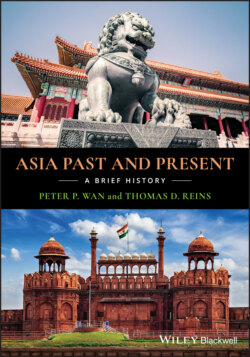Читать книгу Asia Past and Present - Peter P. Wan - Страница 79
Timeline: Premodern Korea to 1897
Оглавление| 700,000 BCE | Humanlike beings appear on the Korean Peninsula |
| 10,000 BCE | Paleolithic hunters and gatherers of the Old Stone Age |
| 1500 BCE | Agricultural villages appear; rice cultivation introduced from China 1200–900 BCE |
| 800 BCE | Bronze Age begins |
| ca. 4th century BCE | GoJoseon Dynasty established; centralized kingdom |
| 3rd century BCE | Iron Age begins |
| 200–100 BCE | Jin State emerges in southern Korean Peninsula |
| 194–198 BCE | Wiman Joseon Dynasty founded by defeated rebel Han Chinese general at Pyongyang |
| 109–108 BCE | China’s Han Wudi, the Martial Emperor, unseats Wiman Joseon Dynasty and sets up Four Chinese Commanderies |
| 57 BCE–668 CE | Three Kingdoms |
| 37 BCE–668 CE: Goguryeo | |
| 57 BCE–935 CE: Silla | |
| 18 BCE–660 CE: Baekje | |
| 698–926 | Northern and Southern Dynasties |
| 668–935: Unified Silla | |
| 698–926: Unified Balhae | |
| 892–936 | Later Three Kingdoms: Silla, Later Baekje, and Later Goguryeo |
| 918–1392 | Unified Goryeo, from where the English word “Korea” comes |
| 1234 | Metal, moveable‐type printing press invented |
| 1270–1350s | Mongol conquest |
| 1392–1897 | Unified Yi Joseon Dynasty |
| 1402 | Paper currency in circulation |
| 1424 | Compilation of History of Koryo completed |
| 1446 | Hangeul, the Korean phonetic spelling system, adopted |
| 1592, 1598 | Toyotomi Hideyoshi attempts to conquer Korea but is defeated by Korean Admiral Yi Sun‐sin’s “turtle boats” |
| 1627, 1636 | Manchu Qing China invades Korea and turns it into a tributary state |
| 1880s–1890s | China and Japan work to keep Russia out of Korea |
| 1894–1895 | Japan defeats China in the First Sino‐Japanese War, ending Korea’s tributary and protectorate status |
| 1897 | Yi Joseon Dynasty collapses; Korean Empire created |
The earliest forms of agricultural society on the Korean Peninsula had emerged by 1500 BCE. Villages surfaced and grew into societies led by chieftains. In southern Korea, they engaged in intensive agriculture in dry and paddy fields, and grew a multitude of crops, such as millet, red bean, soybean, and rice. As was the case in other civilizations, bronze was only used to make weapons and ceremonial items, but not farm tools. Most of the population lived in rectangular pit‐houses, but walled cities were already appearing. Dolmen burial sites became increasingly elaborate and numerous. (A dolmen is a single‐chamber megalithic tomb for the burial of important persons. Over 40% of the world’s dolmens are found on the Korean Peninsula.)
Korean mythology has it that the first Korean state, often called the GoJoseon Dynasty, was founded in 2333 BCE by the son of the Divine Creator and a female bear in human form. Modern historians generally agree that the GoJoseon Dynasty became a centralized kingdom before the fourth century BCE. (Note: In Korean, “Joseon” means “Land of the Morning Calm,” and “go” means “ancient.” To combine “Go” and “Joseon” distinguishes this ancient Joseon dynasty from the Yi Joseon Dynasty of the fourteenth century.)
